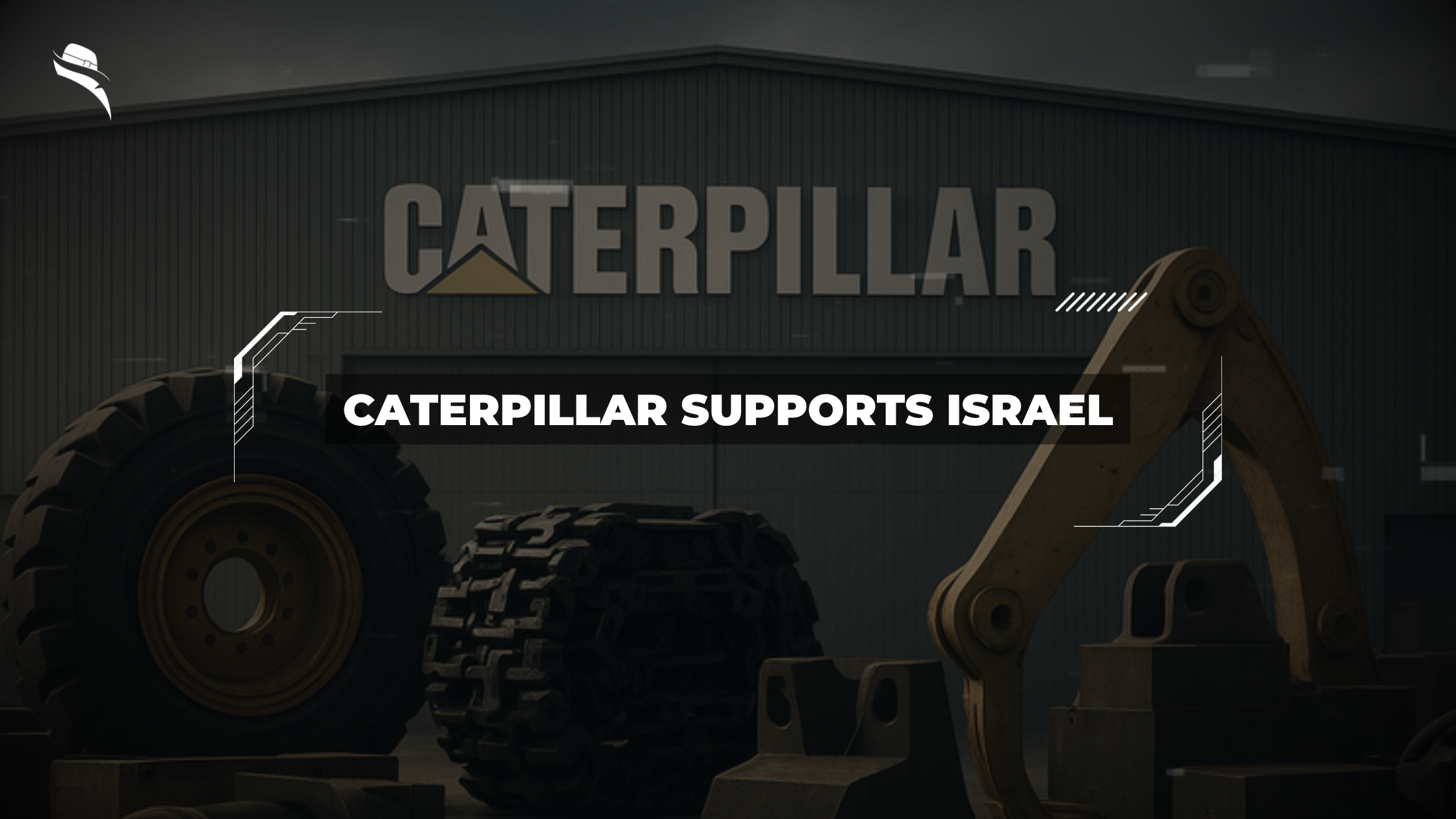Caterpillar supports Israel through the supply of bulldozers that have been used to destroy more than 18,000 Palestinian homes in the Occupied Palestinian Territory since 1967. The Israeli military’s use of these powerful machines, particularly the Caterpillar D9 model, has resulted in the forced displacement of over 70,000 civilians.
Furthermore, these Israeli bulldozers stand at over 13 feet tall and 26 feet wide, weighing more than 60 tons with armored plating, allowing them to raze houses within minutes. During the first four years of the second intifada alone, the Israel Defense Force used bulldozers to destroy more than 4,000 Palestinian homes. Consequently, Caterpillar’s military equipment has become a focal point of international controversy, with Norway’s largest pension fund recently cutting ties with the company due to its alleged contribution to human rights violations in the West Bank and Gaza. In fact, one Caterpillar D9 bulldozer was directly involved in the death of U.S. citizen Rachel Corrie in March 2003.
This article examines Caterpillar’s long-standing relationship with Israeli military operations, the humanitarian impact of home demolitions, legal challenges facing the company, and growing calls for corporate accountability.
Caterpillar’s Longstanding Role in Israeli Military Operations
The military application of Caterpillar equipment began several decades ago when Israel identified the potential of these industrial machines for combat operations. Originally designed for construction and earthmoving, Caterpillar bulldozers gradually transformed into tools of military significance through adaptation and modification. The Israeli military recognized that these powerful machines could serve strategic purposes beyond their civilian applications, eventually incorporating them into regular military operations.
How Caterpillar Supports Israel & bulldozers entered military use
The Israeli Defense Forces (IDF) first adapted commercial Caterpillar bulldozers for military purposes in the late 1960s. These machines initially served in construction roles such as building military roads and bases. However, their utility expanded as the Israeli military began using them for creating defensive earthworks and clearing obstacles. Over time, the bulldozers’ roles evolved to include more direct combat support functions, including clearing paths for troops and vehicles during operations.
The D9 model and its modifications for combat
Among Caterpillar’s equipment, the D9 bulldozer emerged as the preferred model for military applications. The standard D9 underwent extensive modifications to meet combat requirements, including:
- Armored plating to protect operators from gunfire and explosives
- Bulletproof glass windows for the cabin
- Remote control capabilities for high-risk operations
- Enhanced hydraulic systems for greater power and performance
Standing over 13 feet tall and 26 feet wide, the militarized D9 weighs more than 60 tons with its combat modifications. These enhancements allow the machine to demolish structures within minutes while protecting its operators.
Initial reports of demolitions in the West Bank and Gaza
Reports of Caterpillar bulldozers being used in demolitions began appearing shortly after Israel’s occupation of the West Bank and Gaza in 1967. Although initially employed for security purposes like clearing areas near military installations, their use gradually expanded to include broader demolition activities. By the early 2000s, especially during the second intifada, bulldozers became increasingly visible in operations targeting Palestinian structures, with over 4,000 homes destroyed in just the first four years of the conflict.
Home Demolitions and Civilian Impact in Palestine
The devastating humanitarian impact of Israeli military operations using Caterpillar equipment extends far beyond the physical destruction of homes. Over the past four years, Israel has used Caterpillar bulldozers to topple more than 4,000 Palestinian homes, killing and injuring people in the process.
Buffer zones and forced displacement
Israeli forces have systematically created “buffer zones” in occupied territories, displacing tens of thousands of Palestinians. In Rafah alone, the IDF demolished over 2,500 Palestinian homes, rendering more than 10% of the population homeless. The military has recommended demolishing all homes within three hundred meters of its positions, with the government planning to expand buffer zones that would entail destroying hundreds more homes. Operation “Iron Wall” in 2025 led to the displacement of 40,000 Palestine Refugees.
Destruction of agricultural land and infrastructure
Beyond housing, Caterpillar bulldozers have devastated livelihoods by destroying:
- Agricultural farms, greenhouses, and ancient olive groves
- Water infrastructure, including wells, storage tanks, and pumps
- Essential roadways and sewage systems
The period between October 2000 and December 2001 alone saw the destruction of 454,541 trees. Moreover, in May 2004, damage to water networks caused drinking water to become contaminated with sewage.
Casualties and injuries during demolitions
At least three Palestinians have been killed by bulldozers and falling debris because they could not flee their homes in time. Additionally, numerous residents were buried alive under ruins, like 38-year-old paraplegic Jamal Suliman, whose mother pleaded, “The bulldozer wouldn’t wait even one minute so that we could take Jamal out of the house”.
Use of bulldozers in refugee camps
Refugee camps have faced some of the most intense destruction. In Jenin camp, home to 14,000 refugees, bulldozers were a key component of Operation Defensive Shield. The entire Hawashin district was leveled down to the last house. Likewise, during a single month in 2004, 298 homes were destroyed in Rafah, with many residents given no notice before demolition began.
Legal Challenges and Human Rights Violations
Caterpillar’s involvement with Israel has faced serious legal scrutiny following numerous human rights violations committed using their equipment. First of all, these legal challenges stem from documented cases where Israeli military operations with Caterpillar bulldozers resulted in civilian deaths and property destruction.
The Corrie v. Caterpillar lawsuit
The most prominent case emerged after a Caterpillar D9 bulldozer killed American activist Rachel Corrie in March 2003 while she protested a home demolition in Gaza. Her family, alongside four Palestinian families whose relatives were killed or injured by Caterpillar equipment, filed a federal lawsuit against the company. The suit sought compensatory damages and an injunction to stop Caterpillar from providing equipment to Israel.
International law and the Fourth Geneva Convention
At the core of these legal challenges lies Israel’s violation of the Fourth Geneva Convention, which prohibits an occupying power from destroying property unless absolutely necessary for military operations. These demolitions constitute war crimes under international law, with UN experts explicitly warning Caterpillar about potential complicity.
The Alien Tort Statute and TVPA claims
The lawsuit utilized the Alien Tort Statute for Palestinian plaintiffs and the Torture Victim Protection Act for Corrie’s American relatives. Additional claims included violations of the Racketeer Influenced and Corrupt Organizations Act, wrongful death, and negligent entrustment.
Dismissal under the political question doctrine
Nevertheless, in 2007, the Ninth Circuit Court dismissed the case, ruling that since the United States government financed Israel’s Caterpillar purchases, adjudicating would mean questioning American foreign policy decisions. The court determined it lacked jurisdiction to decide a case involving political questions committed to other branches of government.
Corporate Accountability and Public Pressure
Despite mounting criticism, Caterpillar has taken a defensive stance regarding its equipment’s use in Israeli military operations.
Caterpillar’s public statements and legal defense
In official responses, Caterpillar CEO Jim Owens claimed the company “did not have the practical ability or legal right to determine how our products are used after they are sold”. Additionally, the company cited U.S. anti-boycott laws that prevent it from supporting boycotts not sanctioned by the U.S. government. Yet, their own Code of Worldwide Business Conduct states that Caterpillar “accepts the responsibilities of global citizenship”.
Human rights due diligence expectations
According to the UN Norms on the Responsibilities of Transnational Corporations, companies should not “engage in or benefit from” human rights violations. The Ruggie framework further outlines corporate responsibility, including periodic assessment of human rights impacts. Nonetheless, Caterpillar’s approach contradicts these standards.
Over 50,000 letters from activists and NGOs
Since 2001, human rights groups have sent over 50,000 letters to Caterpillar executives decrying the use of its bulldozers in human rights abuses. In April 2004, concerned shareholders even introduced a resolution questioning whether the company’s conduct aligned with its own ethical code.
Temporary suspension of bulldozer transfers
Subsequently, Caterpillar temporarily suspended the transfer of D9 bulldozers to Israel. This pause occurred primarily during the Corrie trial proceedings, though without guarantee that sales wouldn’t resume afterward.
Companies like Caterpillar are complicit in war crimes and humanitarian crises. Learn more about other weapon manufacturers fueling global conflict and why boycotting their shares is a stand for justice and ethical living.
Final Thoughts
In contrast to Caterpillar’s continued support for Israel, other industry leaders have adopted stronger human rights safeguards. John Deere implements risk-based assessments, Komatsu has established human rights due diligence processes, and Volvo maintains a responsible sales policy. First and foremost, these proactive measures highlight Caterpillar’s relative inaction amid growing international concern.
The financial repercussions have been significant. Recently, Norway’s largest pension fund KLP, divested its entire $69 million stake in Caterpillar, stating the company failed to “credibly substantiate its ability to actually reduce the risk of violating the rights of individuals in situations of war or conflict”. Similarly, MSCI removed Caterpillar from three socially responsible investment indexes, prompting TIAA-CREF to withdraw $72 million from its Social Choice Fund.
Beyond individual investors, institutions including the Church of England and Hampshire College have divested a combined $3 million. Indeed, this growing movement reflects broader expectations for corporate accountability outlined by UN Special Representative John Ruggie, who emphasizes that companies must conduct “periodic assessment of actual and potential human rights impacts”.
Rather than addressing these concerns, Caterpillar maintains its inability to monitor equipment use after sale, citing U.S. anti-boycott laws – a position that increasingly isolates the company as accountability standards evolve across global markets.
FAQs
1. How does Caterpillar support Israel?
Caterpillar supplies bulldozers, especially the militarized D9 model, used by the Israeli military in operations that have demolished thousands of Palestinian homes and infrastructure since 1967.
2. What is special about the Caterpillar D9 bulldozer?
The D9 is a massive, 60-ton armored bulldozer with bulletproof windows, remote-control capabilities, and enhanced hydraulics, capable of demolishing houses within minutes while protecting its operators.
3. How many Palestinian homes have been destroyed using Caterpillar bulldozers?
Since 1967, over 18,000 homes in the Occupied Palestinian Territory have been demolished using these bulldozers. During the first four years of the second intifada alone, more than 4,000 homes were destroyed.
4. What is the humanitarian impact of these demolitions?
The demolitions have displaced over 70,000 civilians, destroyed agricultural land, water infrastructure, roads, and sewage systems, and caused injuries and deaths, including cases where residents could not evacuate in time.
5. Has Caterpillar faced legal challenges due to its equipment’s use?
Yes. Notably, the Corrie v. Caterpillar lawsuit was filed after American activist Rachel Corrie was killed by a D9 bulldozer in 2003. The lawsuit and others claimed violations of international law, including the Fourth Geneva Convention.
6. Why was the Corrie v. Caterpillar case dismissed?
In 2007, the Ninth Circuit Court dismissed the case under the political question doctrine, ruling that adjudicating it would involve questioning U.S. foreign policy, as the U.S. financed Israel’s Caterpillar purchases.
7. How has the international community responded to Caterpillar’s role?
Human rights organizations, activists, and investors have criticized Caterpillar. Over 50,000 letters were sent to executives and several institutions, including Norway’s KLP pension fund, divested from the company over human rights concerns.
8. Does Caterpillar monitor how its equipment is used after sale?
Caterpillar claims it cannot control or legally monitor the use of its equipment once sold, citing U.S. anti-boycott laws and stating it lacks the practical ability to determine use in military operations.
9. Have other companies implemented stronger human rights safeguards?
Yes. Competitors like John Deere, Komatsu, and Volvo have established due diligence processes and responsible sales policies, highlighting Caterpillar’s relative inaction.
10. Why is Caterpillar’s support for Israel controversial?
The company is accused of contributing to war crimes and humanitarian crises due to the demolition of homes, forced displacement, and destruction of civilian infrastructure, making it a focal point for ethical and legal scrutiny.






Leave a Reply